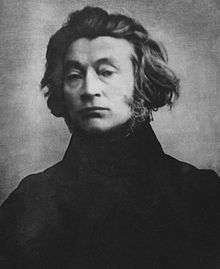Ode to Youth

"Ode to Youth" (Polish: "Oda do młodości") is an 1820 Polish poem by Adam Mickiewicz.
Background and critical reception

"Ode to Youth" was one of Mickiewicz' first poems, and one of his most popular and enduring ones, although the reception among critics has been mixed. It has been described by one literature scholar, Ignacy Chrzanowski, as "Mickiewicz's first masterpiece"; another scholar, Juliusz Kleiner, disagreed.[1]
The theme of the poem is the duties and rights of the youth in the service of an overarching, higher ideal.[2] The youth are said to have a moral obligation to take action.[3] Michael Ferber describes it as "unabashedly Schillerian in inspiration", and notes that the poem "deftly exploits neo-Classicist poetics in order to subvert the discourse that engendered them."[4] The poem has also been described as a manifesto of the secret student organization, the Philomaths, to which Mickiewicz belonged at that time.[5]
Publishing
Mickiewicz finished the poem in 1820, the year of his debut as a poet, but it was not included in his first tome of poetry, published that year.[2] This was because the "Ode" was seen as too patriotic and revolutionary for publication in the Russian portion of partitioned Poland where Mickiewicz spent his youth, and as such rejected by the reviewing Russian censor in Vilnius.[2][6][7] It would not appear officially for many years, but unofficial copies were made in such numbers that at the time of the November Uprising (an unsuccessful Polish insurrection against the occupying Russian forces) in 1830 the poem was already well known.[2] Koropeckyj writes that "copied and recopied among the youths of Vilnius and soon enough beyond ... [it] became the hymn of a generation."[8]
The work was first published, unauthorized, in Lviv (in the Austrian Partition) 1827; the first version authorized by Mickiewicz was published in Paris in 1838.[9][10][11]
References
- ↑ Kazimierz Świegocki (1 January 2006). "Czy Oda do młodości jest arcydziełem?". Od Romantyzmu Do Postmodernizmu: Wybrane Szkice Literackie Z Lat 1970-2003. Instytut Wydawniczy "Pax". p. 33, 39. ISBN 978-83-211-1761-4. Retrieved 13 June 2013.
- 1 2 3 4 Kazimierz Wyka, "Mickiewicz, Adam Bernard", Polski Słownik Biograficzny, vol. XX, 1975, p. 695.
- ↑ Stephen Prickett; Simon Haines (2 September 2010). European Romanticism. Continuum International Publishing Group. p. 48. ISBN 978-1-4411-1764-9. Retrieved 13 June 2013.
- ↑ Michael Ferber (15 April 2008). A Companion to European Romanticism. John Wiley & Sons. p. 327. ISBN 978-1-4051-5453-6. Retrieved 13 June 2013.
- ↑ Elwira Buszewicz (2003). Słownik pisarzy polskich. Zielona Sowa. p. 323. ISBN 978-83-7389-123-4. Retrieved 13 June 2013.
- ↑ Roman Robert Koropeckyj (1 January 2008). Adam Mickiewicz: The Life of a Romantic. Cornell University Press. p. 29. ISBN 978-0-8014-4471-5. Retrieved 13 June 2013.
- ↑ Krystyna Tokarzówna; Instytut Badań Literackich (Polska Akademia Nauk) (1972). Maria Konopnicka: materiały z sesji naukowej w 60 rocznice̜ s̀mierci poetki (Kalisz, 16-17, IX, 1970). Ludowa spółdzienia wydawnicza. p. 96. Retrieved 13 June 2013.
- ↑ Roman Robert Koropeckyj (1 January 2008). Adam Mickiewicz: The Life of a Romantic. Cornell University Press. p. 23. ISBN 978-0-8014-4471-5. Retrieved 13 June 2013.
- ↑ Alina Kowalczykowa (1991). Idee programowe romantyków polskich: antologia. Wyd. Ossolińskich. p. 3. ISBN 978-83-04-02613-1. Retrieved 13 June 2013.
- ↑ Teksty drugie. Instytut Badań Literackich PAN. 1998. p. 33. Retrieved 13 June 2013.
- ↑ Roman Robert Koropeckyj (1 January 2008). Adam Mickiewicz: The Life of a Romantic. Cornell University Press. p. 245. ISBN 978-0-8014-4471-5. Retrieved 13 June 2013.
| Wikisource has original text related to this article: |